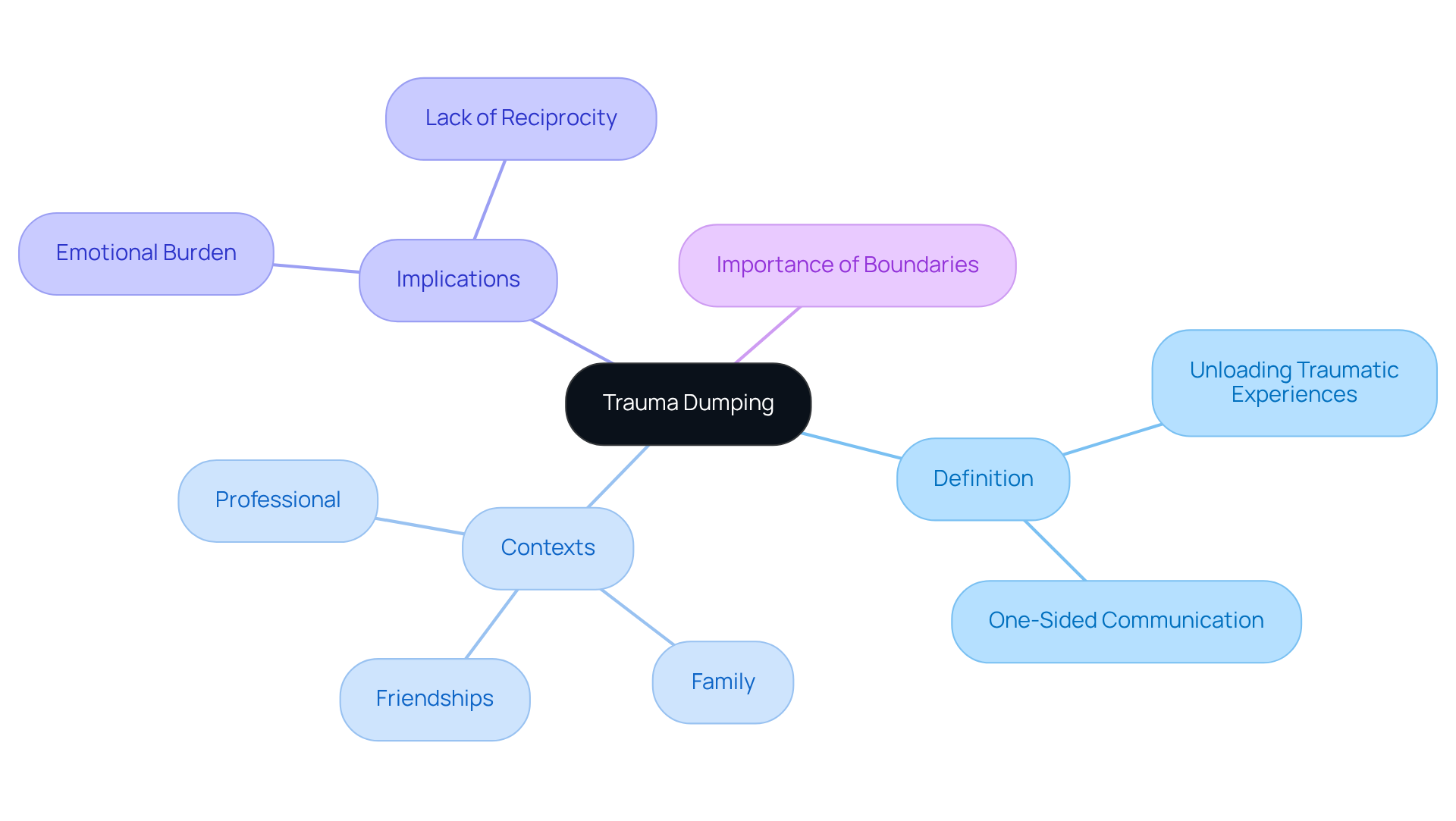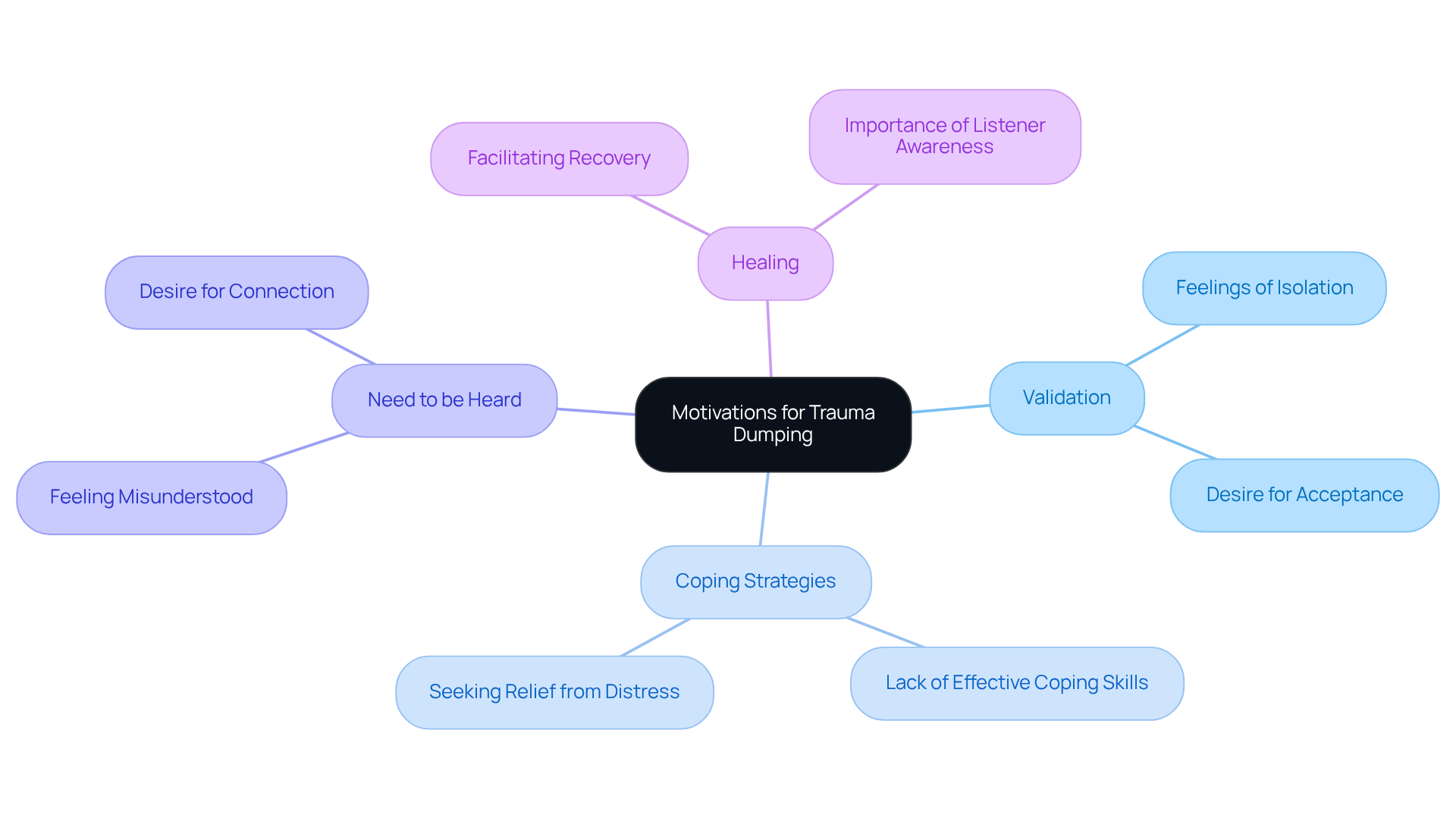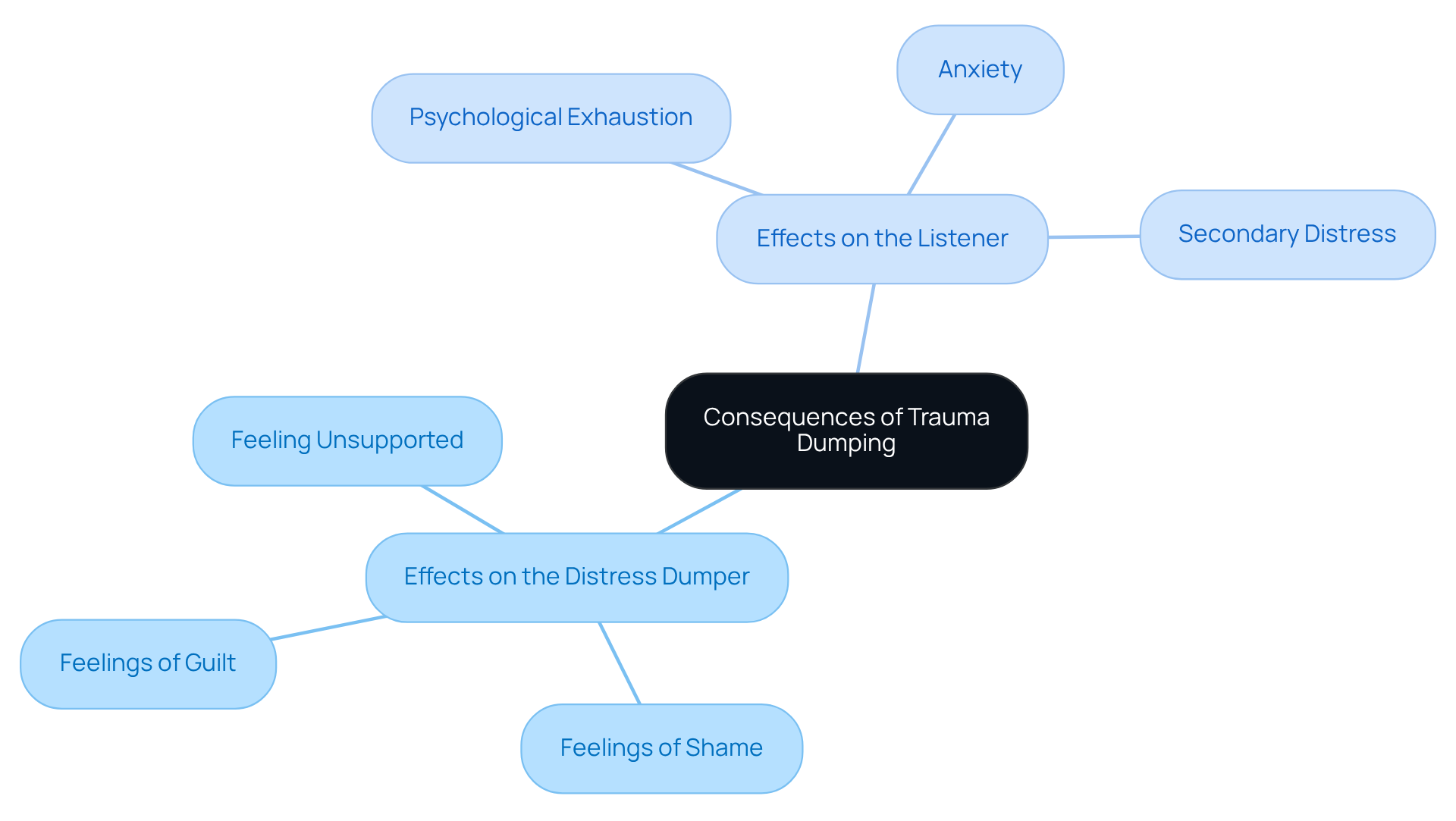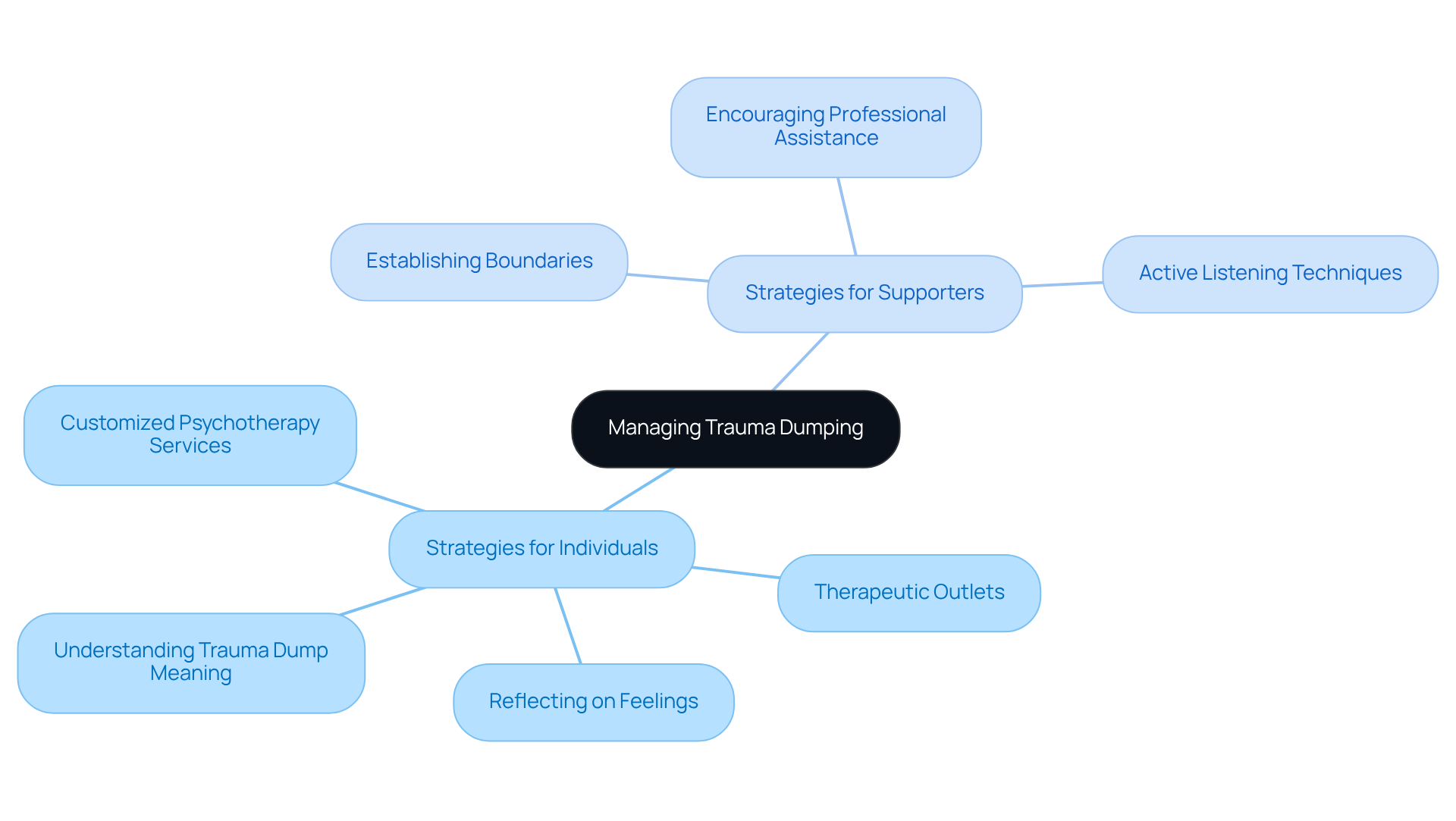Overview
This article delves into the concept of "trauma dumping," which is the act of sharing traumatic experiences with others without considering how it might affect them emotionally. Have you ever felt overwhelmed by your past? It’s crucial to recognize that while sharing our burdens can feel relieving, it can also lead to psychological exhaustion for the listener. This can create feelings of guilt for the person sharing, ultimately straining relationships.
Establishing boundaries and practicing healthy communication is essential. By doing so, we not only protect our own emotional well-being but also show care for those around us. As we explore this further, consider how open dialogue about our experiences can foster deeper connections without overwhelming others. Remember, seeking professional help can be a vital step towards healing, allowing us to process our trauma in a supportive environment.
Introduction
In today’s interconnected world, understanding the nuances of emotional communication is essential. Sharing personal struggles can sometimes blur the lines of healthy interaction. Have you ever felt overwhelmed by your past? This feeling often leads to what is known as trauma dumping—where individuals unload their traumatic experiences onto others.
It raises important questions about boundaries and emotional labor in relationships:
- What happens when the need for connection overshadows the well-being of both the speaker and the listener?
- What are the motivations behind trauma dumping and its significant impacts on relationships?
- What strategies can be employed for fostering healthier conversations, guiding individuals toward a more balanced and supportive exchange?
Ultimately, this journey encourages us to seek healing and connection in a nurturing way.
Defining Trauma Dumping: Understanding the Concept
The trauma dump meaning involves the act of unloading one’s traumatic experiences onto another person, often without considering the emotional burden it may impose on the listener. Have you ever felt overwhelmed by your past? This behavior can occur in various contexts, such as friendships, family interactions, or even professional settings.
While discussing one’s struggles can be a crucial aspect of the healing journey, the trauma dump meaning often refers to unloading issues that typically lacks the reciprocal interaction that defines healthy communication. It frequently appears as a one-sided discussion that illustrates trauma dump meaning, where the person expressing their experiences may not be looking for support or understanding, but rather a way to release their distress.
Understanding this concept is crucial, as it highlights the importance of boundaries and emotional labor in relationships. As we explore this further, remember that seeking support can be a vital step towards healing.

Exploring the Motivations: Why People Trauma Dump
Emotional dumping, which relates to the trauma dump meaning, can stem from various needs, such as a deep desire for validation, a lack of effective coping strategies, or a profound wish to be heard. Have you ever felt overwhelmed by your past? Many individuals who have experienced significant distress may feel isolated and misunderstood, which can lead them to seek connection through sharing their struggles, illustrating the trauma dump meaning. It's important to recognize that some may not fully understand how their sharing affects others, especially if they haven't learned healthy communication skills.
Additionally, the urge to express one’s experiences verbally can arise from a genuine need for healing. Discussing distressing events can often facilitate recovery. However, it’s crucial to remain mindful of the listener's feelings, as sharing burdens without this awareness can unintentionally lead to a trauma dump meaning that strains relationships and creates discomfort. As we explore this further, remember that seeking support is a brave step towards healing.

Consequences of Trauma Dumping: Effects on Relationships and Well-Being
The trauma dump meaning can profoundly affect both the individual sharing their experiences and the person listening. For the distress dumper, this behavior often leads to feelings of guilt or shame, particularly when they realize the burden placed on their listener. Have you ever felt overwhelmed by your past? On the other hand, the recipient may encounter psychological exhaustion, anxiety, or even secondary distress, absorbing pain without sufficient support. This imbalance can strain relationships, as listeners might feel overwhelmed or resentful, while dumpers may feel unsupported or rejected.
Statistics reveal that nearly 20 million views on TikTok under the hashtags #traumadump and #traumadumping highlight the trauma dump meaning, which underscores the need for thoughtful practices. Real-world examples show that listeners can experience significant emotional fatigue, leading to a reluctance to engage in future discussions about distress. Recognizing these consequences is vital for nurturing healthier communication patterns, ensuring that both parties feel valued and understood.
As mental health advocate Maia Petrucha emphasizes, the absence of prompt responses in online interactions can create a compulsive cycle of sharing distressing experiences, further complicating these dynamics. Establishing boundaries and seeking consent before discussing sensitive topics can help alleviate these effects, fostering a more balanced and reciprocal dialogue. In addition to this, consider reaching out for support if you find yourself in these situations, as seeking help is a courageous step towards healing.

Managing Trauma Dumping: Strategies for Individuals and Supporters
Handling emotional overload can be challenging, but setting clear limits and fostering open dialogue is essential. Have you ever felt overwhelmed by your past? Individuals who engage in emotional dumping may benefit from understanding the trauma dump meaning and reflecting on their feelings while seeking suitable therapeutic outlets, such as counseling or support groups. These safe environments allow for the sharing of experiences, which can be incredibly healing.
At The Emerald Couch, we understand the complexities of emotional distress and anxiety. We specialize in providing customized psychotherapy services that include both in-person counseling and telehealth options. Our effective therapeutic methods, like EMDR and Cognitive Processing Therapy (CPT), are designed to empower individuals on their healing journey.
For those supporting someone in distress, it's crucial to establish boundaries. Clearly stating personal limits while encouraging the individual to seek professional assistance can create a supportive atmosphere. Active listening techniques, such as validating feelings without taking on the emotional burden, can also be incredibly helpful.
Creating a safe space for open dialogue about the trauma dump meaning is vital. It allows both parties to navigate these conversations more effectively, ensuring that sharing becomes a mutual and supportive process. Taking the first step towards healing at The Emerald Couch empowers individuals to overcome their pain and personalize their healing journey.

Conclusion
Understanding trauma dumping is essential for fostering healthier communication and emotional well-being. This concept highlights the act of sharing traumatic experiences without considering the emotional toll it may take on the listener. Recognizing trauma dumping as a one-sided exchange emphasizes the need for boundaries and mutual support in relationships, ensuring that both parties feel acknowledged and valued.
Have you ever felt overwhelmed by your past? Key insights include the motivations behind trauma dumping, such as the desire for validation and the lack of effective coping strategies. The consequences of this behavior can lead to psychological exhaustion for the listener and feelings of guilt for the person sharing their experiences. Establishing clear boundaries and encouraging open dialogue can mitigate these effects, promoting a more balanced interaction. Therapeutic support and safe spaces for sharing can also play a crucial role in the healing process.
Ultimately, addressing trauma dumping is vital for nurturing emotional health and fostering supportive relationships. Encouraging individuals to seek professional help and practice active listening can transform these difficult conversations into opportunities for connection and understanding. By prioritizing emotional well-being and setting boundaries, it becomes possible to navigate the complexities of trauma in a way that honors both the sharer and the listener.
Frequently Asked Questions
What is trauma dumping?
Trauma dumping refers to the act of unloading one’s traumatic experiences onto another person without considering the emotional burden it may impose on the listener.
In what contexts can trauma dumping occur?
Trauma dumping can occur in various contexts, including friendships, family interactions, and professional settings.
How does trauma dumping differ from healthy communication?
Trauma dumping often lacks reciprocal interaction, making it a one-sided discussion, whereas healthy communication involves mutual support and understanding.
What might motivate someone to engage in trauma dumping?
The person expressing their experiences may not be seeking support or understanding but rather looking for a way to release their distress.
Why is it important to understand the concept of trauma dumping?
Understanding trauma dumping highlights the importance of boundaries and emotional labor in relationships, which is crucial for maintaining healthy interactions.




